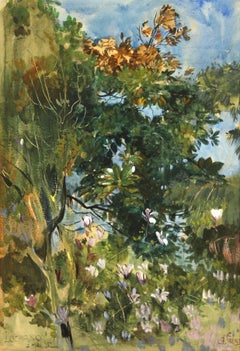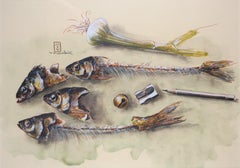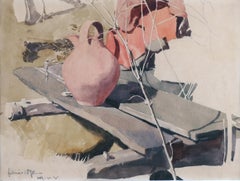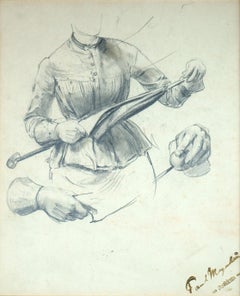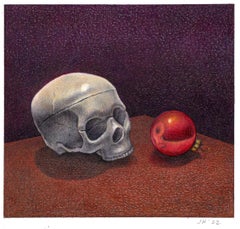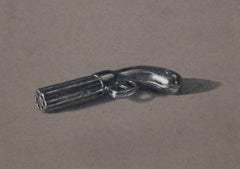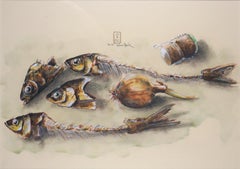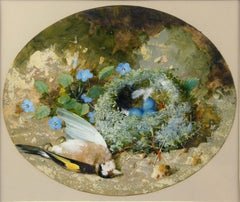Berlin - Still-life Drawings and Watercolors
to
4
3
1
Overall Width
to
Overall Height
to
3
1
1
1
1
2
2
2
2
1
1
1
1
1
1
1
3
3
1
1
1
3
1,192
805
Item Ships From: Berlin
Plant Impression in Locarno - Floral Crescendo -
Located in Berlin, DE
Alexander Frenz (1861 Rheydt - 1941 Düsseldorf). Plant impression in Locarno. Gouache and watercolour. 35 x 23,5 cm (visible size), 49,5 x 38,5 cm (fra...
Category
1890s Impressionist Berlin - Still-life Drawings and Watercolors
Materials
Watercolor
$867 Sale Price
20% Off
Still life with fish bones, pencil and pencil sharpener / - The irony of art -
Located in Berlin, DE
Manfred K. Schwitteck (*1948), Still life with fish bones, pencil and pencil sharpener, 1992. watercolor over pencil on handmade paper, 31.5 x 45 cm (visible size), 47 x 61 cm (frame...
Category
1990s Surrealist Berlin - Still-life Drawings and Watercolors
Materials
Etching, Watercolor
Clay jug on a bench - The essence of the clay jar revealed by the sunlight -
By Hans Richard von Volkmann
Located in Berlin, DE
Hans Richard von Volkmann (1860 Halle (Saale) - 1927 ibid.), Clay jug on a bench. Pencil and Watercolour on paper. 20 x 26,7 cm (visible size), 37 x 45 cm (frame), dated and monogrammed lower left "Februar 1890 - HR. V. V."
- Minimally tanned. Framed behind glass in a passepartout.
About the artwork
Using the technique of his early youth - pencil and watercolour - Hans Richard von Volkmann depicts a still life. However, this is not a conventional indoor still life, but an open-air depiction, painted outdoors and not in the studio. It is therefore an open-air painting, characteristic of von Volkmann's oeuvre, which could have been painted in the Willingshausen colony of painters, where open-air painting was programmatically practised there and the artist stayed there that year.
And indeed, this painting is a manifesto of open-air painting. Von Volkmann demonstrates that leaving the studio for the light of nature leads to an entirely new quality of art. To prove this, he uses the genre of still life, which can be described as the studio subject par excellence. Moreover, light plays an essential role in the classical still life. It is the real protagonist of the still life. And it is precisely this moment, essential to the still life, that von Volkmann exploits to demonstrate the potential of plein-air painting: He presents the objects as they appear in the sunlight. The date of February and the bare branches in the foreground make it clear that this is a clear winter day in bright sunlight. The delicate plant in the foreground casts a clearly defined shadow, as does the jug. However, the shadow is most pronounced on the jug itself: The underside of the handle appears almost black, making the top, and therefore the jug itself, shine all the more brightly. The shining of the objects in the sunlight is also visible on the bench. As complementary phenomena to the shadow zones, light edges can be seen on the boards of the seats and the upper foot of the bench shines entirely in the light. To achieve this intensity of light, von Volkmann activated the bright white of the painting ground.
By depicting the objects in glistening sunlight, von Volkmann demonstrates that this quality of light is only to be found outdoors. And this light leads to a new way of looking at the objects themselves. The jug on the bench seems like an accidental arrangement, as if the artist had stumbled upon this unintentional still life and captured it with fascination. And in this fascination there is a moment of realisation that refers to the objects themselves. It is only when they shine brightly in the sunlight that their true nature is revealed. In this way, sunlight allows the objects to come into their own, so to speak. Sunlight, which is not present in the studio, gives the still life an entirely new dimension of reality, which is also reflected in the colours interwoven by the sunlight: The bench and the jug stand in a harmonious grey-pink contrast to the green of the implied meadow.
The emphasis on the jug as the central subject of the picture also implies that the watercolour has not been completed. This non finito inscribes a processuality into the picture, making it clear that something processual has been depicted, the temporality of which has been made artistically permanent. This is why von Volkmann signed the painting and dated it to the month.
About the Artist
Von Volkmann made his first artistic attempts at the age of 14. He painted many watercolours of his home town of Halle. This laid the foundation for his later outdoor painting.
In 1880 his autodidactic beginnings were professionalised with his admission to the Düsseldorf Art Academy. There he studied under Hugo Crola, Heinrich Lauenstein, Johann Peter Theodor Janssen and Eduard von Gebhardt until 1888. Von Volkmann then moved to the Karlsruhe Academy, where he was Gustav Schönleber's master pupil until 1892.
In 1883 he came for the first time to Willingshausen, Germany's oldest painters' colony, at the suggestion of his student friend Adolf Lins...
Category
1890s Naturalistic Berlin - Still-life Drawings and Watercolors
Materials
Watercolor
Study with Torso, Hands, and Umbrella - The characteristic of the inconspicuous
Located in Berlin, DE
Paul Friedrich Meyerheim (1842 Berlin - 1915 ibid.). Sketch of a female torso with hands and an umbrella. Pencil on paper, 27.5 x 22.5 cm (visible size)...
Category
1890s Realist Berlin - Still-life Drawings and Watercolors
Materials
Pencil
Related Items
Skull and Ornament - Vanitas, Still Life, Color Pencil Drawing, Framed
By John Hrehov
Located in Chicago, IL
Drawings of skulls are often called vanitas, which often contain collections of objects symbolic of the inevitability of death and the transience and vanity of earthly achievements and pleasures; it exhorts the viewer to consider mortality and to repent. This still life vanitas drawing is matted with a heavy white mat and framed in a bronze toned wooden frame measuring 15.75 x 16.25 inches.
John Hrehov
Skull and Ornament
colored pencil on paper
7h x 8w in
17.78h x 20.32w cm
JHR006
John Hrehov
Education
1985 MFA-Painting, University of Illinois at Urbana-Champaign
1981 BFA-Painting, Cleveland Institute of Art, Cleveland, OH.
Solo Exhibitions
2017 John Hrehov, Paintings and Drawings. Tom Thomas...
Category
2010s Surrealist Berlin - Still-life Drawings and Watercolors
Materials
Archival Paper, Color Pencil
Gun from Clue
By A.J. Fries
Located in Buffalo, NY
An original mixed media drawing by American artist A.J. Fries.
Category
21st Century and Contemporary Realist Berlin - Still-life Drawings and Watercolors
Materials
Gouache, Graphite, Paper
The Terrace
By Maurice Savin
Located in London, GB
'The Terrace', watercolour on art paper, by Maurice Savin (circa 1950s). An inviting scene from the South of France depicts a quiet sun terrace on a balmy day with azure skies. The v...
Category
1950s Modern Berlin - Still-life Drawings and Watercolors
Materials
Paper, Watercolor
Study for the Chairlift (Anacapri) - Drawing by Ennio Calabria - 1965
By Ennio Calabria
Located in Roma, IT
Study for the chairlift (Anacapri) is a contemporary artwork realized by Ennio Calabria in 1965.
Mixed colored watercolor on paper.
Hand signed, dated and titled on the lower margi...
Category
1970s Contemporary Berlin - Still-life Drawings and Watercolors
Materials
Watercolor
$589
H 28.75 in W 36.62 in D 0.04 in
View of Rio dei Gesuiti in Venice - Drawing by Carlo Ravagnan - 1970s
Located in Roma, IT
Watercolor on heavy paper realized by Carlo Ravagnan in 1970s.
Hand signed lower right.
Excellent condition.
Category
1970s Contemporary Berlin - Still-life Drawings and Watercolors
Materials
Watercolor
$707
H 22.05 in W 14.97 in D 0.08 in
Hollyhocks and Roses in a Garden with Butterfly
Located in Stockholm, SE
This is a beautiful and highly decorative watercolor painting, featuring a charming garden scene filled with pink and white hollyhocks alongside blooming roses. Nestled among the del...
Category
Late 19th Century Naturalistic Berlin - Still-life Drawings and Watercolors
Materials
Paper, Watercolor
$1,532
H 31.11 in W 26.38 in D 1.19 in
View of Venice - Drawing by Carlo Ravagnan - 1970s
Located in Roma, IT
Watercolor on heavy paper realized by Carlo Ravagnan in 1970s.
Hand signed lower left.
Excellent condition.
Category
1970s Contemporary Berlin - Still-life Drawings and Watercolors
Materials
Watercolor
$648
H 14.97 in W 22.05 in D 0.08 in
1920's Illustration of a Country Girl
Located in Soquel, CA
Finely detailed figurative illustration of a young woman leaning against a fence. The woman is wearing a plaid dress and bonnet with a black ribbon. Some of the landscape has been il...
Category
1920s Realist Berlin - Still-life Drawings and Watercolors
Materials
Paper, Watercolor, Ink, Gouache
$556 Sale Price
20% Off
H 13.5 in W 10.25 in D 0.75 in
Dorothy Fitchew - 20th Century British Watercolor Illustration of Flower Fairies
By Dorothy Fitchew
Located in London, GB
DOROTHY FITCHEW
(1889-1975)
“I Must Go Seek Some Dewdrops Here,
And Hang a Pearl in Every Cowslip’s Ear.”
Midsummer Night’s Dream, Act II, Scene I
Signed l.l.: DOROTHY FITCHEW
...
Category
Mid-20th Century Realist Berlin - Still-life Drawings and Watercolors
Materials
Watercolor
$2,443
H 11.23 in W 7.88 in
1920's Historical Fashion Illustration of Lady in 17th Century Dress
Located in Soquel, CA
Finely detailed historical figurative fashion illustration painted in watercolor in 1921, of a lady in 17th century dress; complete with a full blac...
Category
1920s Realist Berlin - Still-life Drawings and Watercolors
Materials
Paper, Watercolor
$556 Sale Price
20% Off
H 12.25 in W 10.25 in D 0.75 in
View of Venice - Drawing by Carlo Ravagnan - 1980
Located in Roma, IT
Watercolor on heavy paper realized by Carlo Ravagnan in 1980.
Hand signed lower left. Date on rear,
Excellent condition.
Category
1980s Contemporary Berlin - Still-life Drawings and Watercolors
Materials
Watercolor
$648
H 14.97 in W 22.05 in D 0.08 in
View of Venice (Ponte di Rialto) - Drawing by Carlo Ravagnan - 1970s
Located in Roma, IT
Watercolor on heavy paper realized by Carlo Ravagnan in 1970s.
Hand signed lower right.
Excellent condition.
Category
1970s Contemporary Berlin - Still-life Drawings and Watercolors
Materials
Watercolor
$707
H 14.97 in W 22.05 in D 0.08 in
Previously Available Items
Still life with fish bones, pencil and pencil sharpener
Located in Berlin, DE
Manfred K. Schwitteck (*1948), Still life with fish bones, pencil and pencil sharpener, 1992. watercolor over pencil on handmade paper, 31.5 x 45 cm (visible size), 47 x 61 cm (frame...
Category
1990s Surrealist Berlin - Still-life Drawings and Watercolors
Materials
Pencil, Watercolor
H 18.51 in W 23.63 in D 0.79 in
Still life with dead goldfinch - The mystic blue transcends death -
Located in Berlin, DE
William Cruickshank (1848-1922). Still Life with a Dead Goldfinch and Nest. Watercolour and gouache on buff paper, 21 x 24.5 cm (visible size), 40 x 42 cm (frame), signed W Cruickshank on the left. Framed behind glass in a passpartout.
About the artwork
The painting has an atmosphere of melancholy beauty. The clutch of eggs, recalling the wonderfully mysterious blue of Romanticism, the matching blue flowers and the goldfinch with its black, yellow and red plumage show nature in all its beauty, and yet the goldfinch is dead. It lies on its back, its head bent backwards in an unnatural way, its claws lifeless and one wing outstretched in a last effort. This makes the scene a natura morta, a still life that spreads the melancholy silence of an eternal moment. Yet there is also an inherent movement in the picture, enhanced by the streaky application of paint.
A movement that here signifies the intertwining of life and death: death, which the goldfinch has met in mid-life, before it has been able to hatch its offspring, while at the same time the mysterious blue eggs that have not hatched point to a higher life after death. Finally, the goldfinch feeding on the thorny thistles traditionally represents Christ and his redemptive sacrificial death. The goldfinch is depicted in a similar way in Carel Fabritius' famous painting The Thistle Finch (1654), in the Mauritshuis in The Hague. The bird is alive, but chained and thus prevented from flying.
In this tradition, Cruickshanks' painting is a memento mori that is immediately appealing to today's viewer - a meditative image of life and death that also contains an affirmation of life in all the beauty of creation. In order to enhance the readability of this pictorial sense, the objects depicted are tilted into the plane so that the individual elements of the picture can be more easily related to one another, but without destroying the sense of space.
Cruickshank, who specialised in this type of painting, combined the emblematics of the Baroque with the imagery of Romanticism and a style borrowed from landscape painting. Cruickshank's mastery of materials is evident in his fusion of watercolour and gouache, in which the more intense colours of gouache concretise the motif from an indeterminate, moving colour space. The painted objects have the aesthetic quality of fine painting, although, as in the case of the nest, they are formed by a virtuoso structure of blotches.
Selected bibliography
Algernon Graves: The Royal Academy of Arts. A complete dictionary of contributors and their work from its foundation in 1769 to 1904, vol. 2: Carroll to Dyer, London 1905.
Leo R. Schidlof: The miniature in Europe. In the 16th, 17th, 18th, and 19th centuries, vol. 1: A - L, Graz 1964.
Jeremy Maas: Victorian painters, London 1996.
Daphne Foskett: A Dictionary of British miniature...
Category
1890s English School Berlin - Still-life Drawings and Watercolors
Materials
Watercolor, Gouache
